

PYROTECHNIC INDUSTRY OUTLOOK
The fireworks industry has changed drastically over the last several years. New changes in safety rules, and government regulations are implemented all the time. The future of pyrotechnics remains unclear. Many fireworks companies have closed their doors, and some cities do not have, or have very limited budget for 4th of July fireworks displays. Economy has also played a major role and resulted in higher cost of manufacturing materials and cost of displays has thus increased. Importing from China also became increasingly difficult and domestic manufacture is very costly. Poor safety conditions have caused many fireworks accidents in China's manufacturing facilities every year. More deaths result in fireworks accidents, not only in the consumer section, but also during public displays. The pyrotechnics industry is greatly affected by these new developments, thus resulting in higher prices charged by display companies, and only time will tell the future of fireworks displays across the country.
We are approved Training course and will hold Continuing Education classes for Proximate Pyrotechnics and Flame Effects Safety for the State of Tennessee State Fire Marshals Office, The State of Missouri State Fire Marshals office and State of Ohio Trainer. We can give Continuing Education Credit.
Seminars Coming Spring 2017
Continuing Education For Indoor Pyrotechnic
Continuing Education For Flame Effects Safety
Zigmont Magic FX Inc 813 689 6269 zigmont@zigmont.com
Our State licensees and Operator Certified
Our documentation of State licensees and Operator Certification in NFPA 1126 and 160
Safety for Pyrotechnics and Propane flames
The NFPA 1126.2016 is now the standard benchmark Safely
Safety is the number one priority at Magic F/X. Our trained staff uses exclusively High Quality, legally approved materials and products. The state of art controlled ignition of the Pyrotechnics effects guarantees a degree of safety that you can rely on- and the perfect timing of the show. We pride ourselves in working with local authorities to produce a show that is as safe as possible. We have helped with training workshops for the Ohio Fire Academy Training School for Fire Marshals and other Fire Authorities.
We are approved Training Coarse and Continuing Education for Proximate Pyrotechnics, and Flame Effects Safety for the State of Tennessee State Fire Marshals Office, The State of Missouri State Fire Marshals office and State of Ohio Trainer. We can give Continuing Education Credit.
Our custom design and professional staging of your indoor fireworks event can take your product launch, sporting extravaganza or corporate award banquet to the next level. We are ready to WOW your audience and rock your event.
Magic F/X offers Pyrotechnical Displays that will ignite the inside of a hotel ballroom or an outdoor stadium with excitement and energy. Enter into a new realm of expression and visualization with a signature piece in the form of a specialized custom full scale indoor/outdoor close proximate pyrotechnics, flame, snow, smoke and other special effects designed by our team. Let us show you the Magic, in Magic F/X.
Zigmont Magic F/X, Inc. holds various licenses with the Federal Bureau of Alcohol, Tobacco, Firearms and Explosives, the State of Ohio, Texas, Colorado and Florida, and various other localities to allow us to import, transport, store, manufacture and display all types of explosives involved in a pyrotechnic display. Every display Magic F/X shoots shall have permits from the local authorities having jurisdiction. We provide along with the permits a $1,000,000.00 1.4 Explosives liability insurance policy that is required on all pyro shoots.
Pyrotechnic Experience NFPA 1126 Standards
A license should be granted only to an individual who has actively participated
in the setup and loading of at least five performances where pyrotechnic
special effects were used. (At the option of the issuing office, an alternative
number of performances can be permitted to be substituted.)
Formal
Requirements. A license should be granted only to an individual who has met
at least one of the following requirements:
(1) Successful completion of a comprehensive written examination covering this
standard and state laws pertaining to the use of pyrotechnic special effects
(2) Receipt of a competency certificate from a national organization that promotes
the safe use of pyrotechnic special effects
(3) Possession of a license for the use of pyrotechnic special effects issued
by another state
Provisions for License Renewal. A license should be permitted to be renewed upon review of the applicant’s record proving active participation in at least three pyrotechnic special effect performances during the last 4 years and demonstrating that these performances were conducted in a safe manner. The pyrotechnic uses can be of either the indoor or outdoor type.
A Pyrotechnic show
Always hire a trained effects specialist technician that is ATF licensed and NFPA 1126.2006 certified to pull permits, plan, design, buy and operate pyrotechnics for the show.
We submit an application with a plan of action, details of the show and a list of the types, numbers and diagrams of the pyrotechnics devices to be used which is submitted to the local fire department.
How pyrotechnics works — One device that produces a fountain-style spray of bright sparks is called the “gerb,” from the French word for sparks.
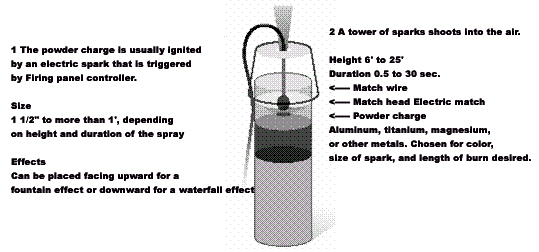
Be Safe and Spectacular
General Safety Rules
Read the general safety rules carefully at least twice! If you have trouble following instructions to the letter, then you should not be involved with pyrotechnics in any way. One small mistake or misread line can lead to disaster. Pyro is very safe in the hands of the careful user.
Keep away from flammables. Fallout from flash pots can ignite other nearby objects. If you can not position the Devices/flash pot at a safe distance from these flammables (at least 15 feet), then you must either treat the flammables with a flame retarding or discontinue the show. Use common sense when making this decision.
Safety - It's your call.
Please
be advised
You will need various licenses/permits with the ATFE Bureau of Alcohol, Tobacco,
Firearms & Explosives and the State/city where you live or performing, and
various other localities to allow to import, transport, store, manufacture and
display (shoot) all types of explosives involved in a pyrotechnic display. The
AFTE permit will allow you to buy Pyrotechnics and fire marshals require these
to shoot.
The other Certification will help you attain a permit from the local authorities
having jurisdiction is a pyrotechnic state license. You must pull a permit from
the local fire dept. and have schedule a fire watch with the fire Marshal's
office. For that you will need to provide a $1,000,000.00 Class "C"
1.4G Explosives liability insurance policy that is required on all pyrotechnic
shoots. This is a policy that is just for pyro and not a general liability policy.
You will have to show you qualifications of NFPA 1126 national fire codes for Standards for the use of Pyrotechnics before a Proximate Audience to obtain the insurance policy and fire permit. A Log Book of shows performed and the related proof that you are qualified for safety and certified in indoor pyrotechnics Heavy fines and arrest can occur if these step are not followed This can include open flame and smoke machines in some cities.
You need to follow National fire codes 101, 1126 to pull a permit. You can't not use pyrotechnics unless you follow all of the above. You will need a pyrotechnics company to provide indoor pyro which knows how to provide the Fire dept a Plan of Action to deal with all the codes and keep the event safe.
Propane
Flame Safety ![]() Always Use
Caution Around Gas
Always Use
Caution Around Gas
Propane- Liquefied petroleum gas (also called LPG, GPL, LP Gas), Colorless, easily liquefied hydrocarbon gas (C3H8 or, more fully, CH3CH2CH3), LPG is available in 2 components one is butane(C4H10) other is Propane(C3H8). Varieties of LPG bought and sold around the world that are different blends. We need C3H8 with at least 21/2 PSI of pressure and a working PSI of 30 - 80 is needed to gain effects. A 2 " bulk tanks to supply effects needs a 2" supply pipe other wise the LPG cylinders are used.
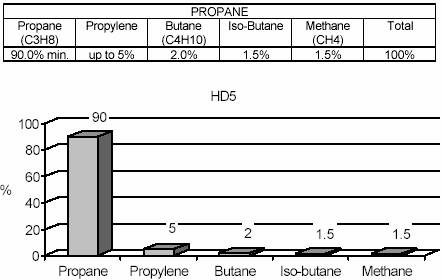
Flame Effect Classification - NFPA 160 Group 3
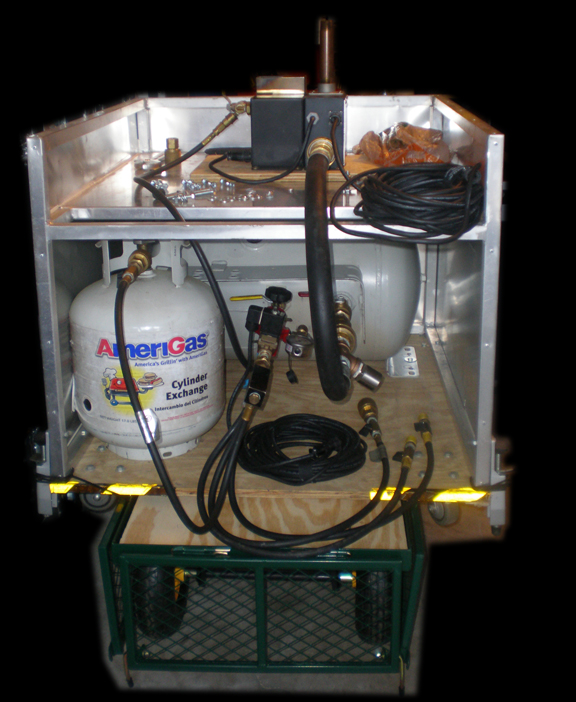
New: NFPA 58 8.3.1(a) 2008 If more than one such cylinder is located in the same room, the cylinders shall be separated by at least 20 ft (6.1 m). 20 feet from doorways, Cylinder not located near exit, stairways or near safe egress of occupants.
(a) The flame effect shall comply with NFPA 160, Standard for Flame Effects Before an Audience.
(b) The maximum water capacity of individual cylinders shall be 50 lb (23 kg) {nominal 20 lb. (9.1 kg) LP-Gas capacity}.
(c) If more than one such cylinder is located in the same room, the cylinders shall be separated by at least 20 ft (6.1 m).
Propane requires a large volume of air to burn properly. In fact, 23.5 cubic feet of air is needed to burn just one cubic foot of propane. With adequate ventilation, an operating burner gives off a number of harmless products such as carbon dioxide and water vapor. But a propane appliance starved of oxygen can quickly produce dangerous amounts of carbon monoxide.
When properly filled, 80 per cent of the cylinder contains liquid propane. The space above the liquid, to the top of the cylinder, holds propane vapor. Enough space must be left in the cylinder to let the liquid propane expand, if the cylinder is exposed to warmer temperatures. Without this space, the “relief valve” may open and release propane, creating a potential safety hazard.
We use a device called an accumulator to produce longer shots, larger shots or more shots. Because the code doesn't’t allow changing cylinders during the show, the operator wants to maximize the fire power from the available 20-pound cylinders. While propane is a liquid, the top portion in a tank is vapor and that’s what burns. Once the vapor is burned off, it takes time for more vapor to be produced from the liquid in the cylinder. The accumulator “sets aside” vapor so the remaining liquid can produce more vapor.
![]() Always Use Caution Around Gas
Always Use Caution Around Gas
A common question we are asked is what pressure is my propane tank? The following should be helpful:
PROPANE CYLINDER LEGEND
BLACK AREA: Represents liquid propane which actually is as perfectly clear as water.
YELLOW AREA: Represents the vapor space and vapor is actually colorless.
YELLOW BUBBLES: Represent the vapor that is created when propane boils.
Tank Pressure Unregulated vapor pressure in any size propane tank can range from about 60 to 120 psi on average. This pressure is not consistent and fluctuates constantly based on the temperature of the propane and the draw of vapor from the upper vapor space. When the temperature of the liquid drops due to the boiling process, the pressure decreases. When the liquid warms the pressure increases. Due to this constant fluctuation and the fact that the engine fuel components operate best at steady input pressures, a regulator must be installed to keep the OUTLET pressure consistently the same or REGULATED. There are two types of regulators in the propane industry as described next.
Boiling Point: 44 degrees
Fahrenheit below zero (Just as the boiling point for water is 212 degrees
above)
bullet
Recovery time: If propane vapor is pulled off very quickly the gas boils very rapidly to replenish the vapor. If the area directly around the liquid can not provide enough heat for the liquid to absorb, the liquid will basically turn into a gel and stop vaporizing. (In theory, a person could carry propane around in a bucket in 50 below zero Antarctica.) The result can be a cylinder that is 1/2 full but have no vapor pressure as if it were empty. When the gas warms up again it will replenish and the liquid will be usable again.
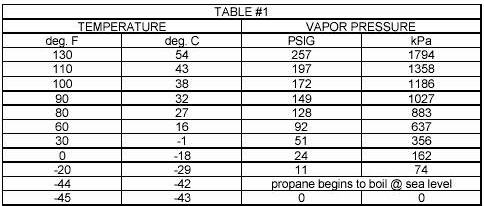
20# cylinders
hold approximately 5 gallons of propane.
bullet
30# cylinders
hold approximately 7 gallons of propane.
bullet
40# cylinders
hold approximately 10 gallons of propane.
bullet
100# cylinders
hold approximately 25 gallons of propane.
bullet
420# cylinders hold approximately 100 gallons of propane.
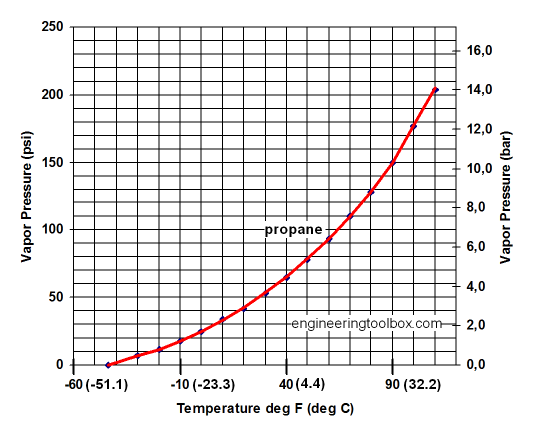
The vapor pressure of propane (C3H8) depends on temperature. Vapor pressure of 100% propane at temperatures ranging -30 - 110oF (-42 - 43oC) are indicated in the diagram and table above.
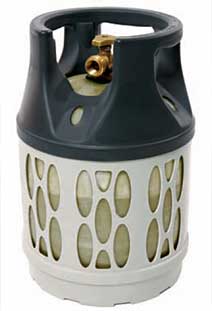
The latest tank available is a fiberglass tank. Fire Marshals are beginning to require to use these because these bottles will not explode in a fire. These tanks are 50% lighter, rust and corrosion free, and clear so you can see how much fuel is left inside.
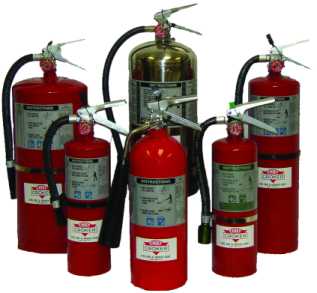
Fire
extinguishers are divided into four categories, based on different types of
fires. Each fire extinguisher also has a numerical rating that serves as a
guide for the amount of fire the extinguisher can handle. The higher the number,
the more fire-fighting power. The following is a quick guide to help choose
the right type of extinguisher.
• Class A extinguishers are for ordinary combustible materials such
as paper, wood, cardboard, and most plastics. The numerical rating on these
types of extinguishers indicates the amount of water it holds and the amount
of fire it can extinguish.
• Class B fires involve flammable or combustible liquids such as gasoline,
kerosene, grease and oil. The numerical rating for class B extinguishers indicates
the approximate number of square feet of fire it can extinguish.
• Class C fires involve electrical equipment, such as appliances, wiring,
circuit breakers and outlets. Never use water to extinguish class C fires
- the risk of electrical shock is far too great! Class C extinguishers do
not have a numerical rating. The C classification means the extinguishing
agent is non-conductive.
• Class D fire extinguishers are commonly found in a chemical laboratory.
They are for fires that involve combustible metals, such as magnesium, titanium,
potassium and sodium. These types of extinguishers also have no numerical
rating, nor are they given a multi-purpose rating - they are designed for
class D fires only.
C02 Safety
Carbon Dioxide, CO2, is a tasteless, colorless, odorless, nonflammable, liquefied gas. Carbon dioxide is an integral part of the basic life cycle in nature. It is exhaled by humans and animals and used by plants to help them grow. Plants, in turn, release oxygen, which people depend on for survival. Carbon dioxide cannot catch fire.
C02 effects are composed primarily CO2, which can be harmful when breathed in a concentrated form, so don’t let anyone breathe it directly. Used as directed our C02 nozzles are safe.
• “Keep your head out of fumes. Do not breathe fumes
and gases. Use enough ventilation, local exhaust, or both to keep fumes and
gases from your breathing zone” But Using C02 special effects in a open
ventilated arena with the C02 shooting for a number of second at a time with
close intervals is completely safe and used at major theme parks and clubs
small and large all over the world.
The key is to aim the keep the nozzle 10 feet from the heads of the target
audience and allow the end of the plume created to hit the dance floor.


We have setup and executed special effects and pyrotechnical displays in the following cities, states and countries:
Major Cities; Boston, New York City, Long Island NY, Albany NY, Buffalo NY, Los Angles, Washington DC, Philadelphia, Hartford, Montreal, Toronto, Rochester, Buffalo, Detroit, Chicago, Tampa, Orlando, Minneapolis.
US States; TN, NJ, PA, OH, WV, KY, IN, IL, IA, WI, MA, FL, SC, GA, DE, VT, CO, VA, IL. and Puerto Rico
17 Countries including; Grand Turk, Finland, Norway, Sweden, Germany, Italy, Austria, Czechoslovakia, France, Belgium, Holland, England, Brazil, Argentina, Mexico, USA, Canada.

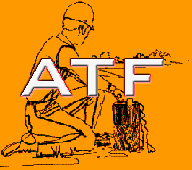


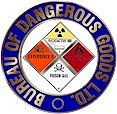
Pyrotechnics Guild International aka PGI fireworks information
1.4
The current and correct US DOT classification for fireworks that replaced the old Class C classification. The most common classification is UN 0336 Fireworks, 1.4 for Display or CPSC (US Consumer Product Safety Commission) Consumer Fireworks, or UN 0431 Articles, Pyrotechnic 1.4 for Pyrotechnic Special Effects (SPFX). There are different packing groups that provide for different possible methods of transportation, hence the letters g or s after the 1.4.
The 1.4 classification means the items as packed in this container or carton present "no significant hazard beyond the package in the event of ignition or initiation during transport". Most CPSC Consumer Fireworks are now classified as 1.4g or 1.4s. Some fireworks classified as 1.4 are Display Fireworks that have more composition than is allowed by CPSC regulations or are not labeled for consumer use for fireworks available for sale to the general public. See Class C.
1.3
The current and correct US DOT classification for fireworks that replaced the old Class B classification. The most common classification is UN 0335 Fireworks, 1.3 and most Display Fireworks are now classified as 1.3g.
The 1.3 classification means the items as packed in this container or carton present "fire hazard and either a minor blast hazard or a minor projection hazard or both but not a mass explosion hazard" (unless a combined massive accidental chain reactions explosion which causes a mass explosion). Some Display Fireworks that are smaller, such as gerbs, fountains, drivers, lance, and some components but that do not meet the requirement for CPSC Consumer fireworks are classified as 1.4. See Class B.
Class CAn obsolete DOT classification for fireworks that is still commonly used as the broad label for CPSC Consumer Fireworks approved for sale to the general public. It was often used in an abbreviated way to describe all Common Fireworks. See 1.4.,UN 0336.
Common Fireworks
The old designation for fireworks approved by the CPSC for sale to and use by the general public. See Consumer Fireworks.
Consumer Fireworks
Any small fireworks that produces a visible or audible effect by combustion or deflagration and that meet the requirements of the CPSC for the quantity of internal composition, construction, size, and labeling for sale to and use by the general public. They are typically classified as UN 0336 Fireworks, 1.4g or 1.4s by the US DOT. See Common Fireworks and Consumer Fireworks.
Display FireworksAny fireworks that produces
a visible or audible effect by combustion or deflagration and that do not meet
the requirements of the CPSC for the quantity of internal composition, construction,
size, and labeling for sale to and use by the general public. They are classified
1.3g UN 0335 Fireworks, or 1.4g UN
0336 by the
US DOT.
EX Number The identification number
assigned to a commercial fireworks device by the Department of Transportation.
All legal commercial fireworks must have an EX Number. Aerial
shells that are 8 inches or larger in diameter are now classified as 1.1G instead
of 1.3G.
Consumer fireworks device
The legal limit of explosive material in a consumer (1.4G or Class C) firework is 50 mg (about the size of half an aspirin tablet). Any item containing more than 50 mg is illegal and should be avoided.
Theatrical Pyrotechnics
Theatrical Pyrotechnics Pyrotechnic devices for professional use in the entertainment industry similar to Consumer Fireworks in chemical composition and construction but not intended for consumer use.
NFPA
National Fire Protection Association (NFPA) Organization which provides several standards that outline recommendations for the manufacture, storage, transportation, and execution of fireworks.
Standard 1124 Provides the Code for the Manufacture, Transportation, and Storage of Fireworks and Pyrotechnic Articles. Developed by the National Fire Protection Association.
Standard 1126 Provides the Standard for the Use of Pyrotechnics Before a Proximate Audience. Developed by the National Fire Protection Association.
Standards
160 Provides the Standard for the Use Of Flame Effects Before a Proximate Audience.
Developed by the National Fire Protection Association.
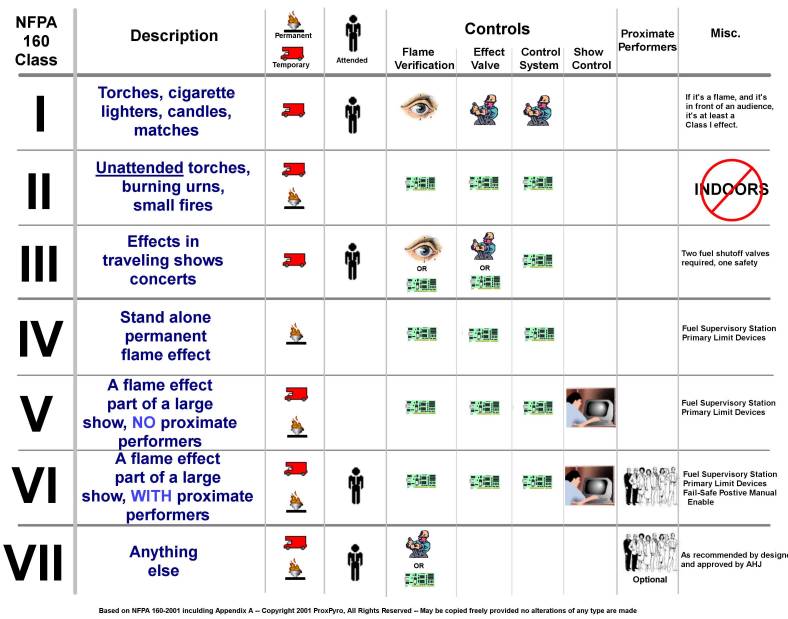
This legal
disclaimer is in no way limited or altered by any other terms or conditions
on this web site.
Web site Material
Zigmont Magic FX Inc Florida Fireworks Fireworks / Indoor Pyrotechnics takes
no responsibility for any error or omission relating to this information. To
the maximum extent permitted by law, Zigmont Magic FX Inc Florida Fireworks
Fireworks / Indoor Pyrotechnics will not be liable for any cost, loss or damage
suffered by you through your use of Zigmont Magic FX Inc Florida Fireworks Fireworks
Fireworks / Indoor Pyrotechnics internet sites or any information contained
thereon.
Zigmont Magic FX Inc Florida Fireworks Fireworks/Indoor Pyrotechnics does not
guarantee or warrant the accuracy, completeness or currency of any of the information
provided. The contents of this web site are solely intended to provide a general
understanding of the subject matter and to assist our customers and potential
customers assess whether they require further information.
Liability
Zigmont Magic FX Inc Florida Fireworks Fireworks/Indoor Pyrotechnics is not
responsible to you or anyone else for any loss suffered in connection with the
use of this web site or any of the content. This includes, but is not limited
to, the transmission of any computer virus.
Warning
Do not attempt to recreate any FX effects seen on this site. We are professional
and only experienced and legally approved over 21 can provide these services.
Attempting to use propane with our the safety devices that are built in to our
gear as well as firing pyrotechnics devices without training is dangerous. C02
can be very dangerous if your not a Certified effect specialist.
Effectspecialist.com provides pyrotechnics displays and propane flames presentations with full services nationwide We operate in North America United States we can service you in the follow cities with speedy services in;
Special effects for Entertainment Venues and clubs, snow machines Service in
Alabama; Anniston, Birmingham, Dothan, Huntsville, Mobile, Montgomery, Tuscaloosa
High Range - High Volume Artificial or Fake Snow Flake Machines Service in Arizona; Flagstaff, Phoenix, Tucson, Yuma
Propane flames Service in Arkansas; Eureka Springs, Fayetteville, Fort Smith, Jonesboro, Little Rock, Monroe
Snow machines from flurries to a beautiful full blown Snowstorm Blizzard , cyro co2 and ground fog Service in California; Anaheim, Antelope Valley, Antioch, Bakersfield, Burbank, Chico, Eureka, Fresno, Hollywood, Huntington Beach, Inland Empire, Lake Tahoe, Livermore Valley, Long Beach, Los Angeles, Medford, Monterey, Napa Valley, Oakland, Orange County, Palm Springs, Pasadena, Sacramento, San Diego, San Francisco, San Jose, Santa Barbara, Santa Monica, Temecula, Ventura County, Yuma
Theatrical FX and
indoor pyrotechnics displays Service in Colorado: Aurora, Boulder, Colorado
Springs, Denver, Fort Collins, Grand Junction, Vail,
Special effects Service in Connecticut, Danbury, Hartford, New Haven, Stamford
Fake snow machines gas FX flames Service in DC; District of Columbia
Low-level Displays Super Bowl Style Pyro and cyro Service in Delaware; Dover, Georgetown, Wilmington
special effect fake snow machines, foam machines pyrotechnics, fireworks and Propane dragonfly flames Service in Florida; Boca Raton, Daytona, Florida Keys, Fort Lauderdale, Fort Meyers, Fort Pierce, Gainesville, Jacksonville, Marco Island, Melbourne, Miami, Ocala, Orlando, Panama City, Pensacola, Sarasota, Tallahassee, Tampa Bay, West Palm Beach
Fireworks fX Pyrotechnical, fake snow machines Service in Georgia; Albany Athens, Atlanta, Augusta, Columbus, Golden Isles, Macon, Savannah
Special effects Co2 outdoor snowfall machines Service in Hawaii; Hawaii Island, Honolulu, Kauai Island Lanaie Island, Maui, Molokai Island
foam machine rental Service for Idaho; Boise-Pocatello, Coeur D Alene, Idaho Falls, Lewiston, Sandpoint, Twin Falls
Pyrotechnics and flames Service in Illinois; Bloomington, Champaign, Chicago, Davenport, Evanston, Mt. Vernon, Oak Lawn, Peoria, Quincy, Rockford, Springfield, Wheaton
FX fire and pyrotechnics table top gerbs Services Indiana; Evansville, Fort Wayne, Hammond, Indianapolis, Lafayette, South Bend, Terre Haute
Evaporating DRY Snow machines, pyrotechnics and flames Service in Iowa ; Cedar Rapids, Davenport, Des Moines, Ottumwa, Quincy, Rochester, Sioux City
Fireworks pyrotechnics, propane flame, snow machines Service in Kansas ; Dodge City, Goodland, Great Bend, Kansas City Lawrence, Manhattan, Salina, Topeka, Wichita
Full event services, snow machine FX Kentucky; Ashland, Bowling Green, Elizabethtown, Hopkinsville, Lexington, Louisville, Owensboro, Paducah
Bubbles FX, pyro Service in Louisiana ; Alexandria, Baton Rouge, Lafayette, Lake Charles, Monroe, New Orleans, Shreveport
inside Pyrotechnics or outdoors pyrotechnics displays Service in Maine; Augusta, Bangor, Lewiston, Ogunquit, Portland, Presque Isle, York
Cyro and snow falling displays Maryland; Annapolis, Baltimore, Columbia, Eastern Shore, Laurel, Montgomery County, Rockville, Salisbury, Southern,Western
Magic FX Service in Massachusetts with low ground fog; Birkshire County, Boston, Cape Cod, Lowell, Springfield, Worcester, Service for Michigan , Ann Arbor, Detroit, Flint, Gaylord, Grand Rapids, Jackson, Kalamazoo, Lansing, Marquette, Port Huron, Saginaw, Saint Clair Shores, Sault Saint Marie, Traverse City, Tri-Cities, Warren,
party foam machines and cyro jets Service in Minnesota; Duluth, Mankato, Minneapolis, Moorhead, Rochester, St. Cloud, St. Paul, Twin Cities
Fireworks and pyrotechnics, flame FX, snow machine rentals Service in Mississippi; Biloxi, Greenwood, Hattiesburg, Jackson, Meridian,Service in Missouri . Clinton, Columbia, Jefferson City, Joplin
Flames and propane fire Kansas City; Ottumwa, Paducah, Quincy, Sedalia, Springfield, St. Joseph, St. Louis,
Next FX protechnics products used in Servicing in Montana; , Billings, Bozeman, Butte, Glendive, Great Falls, Helena, Missoula
Fake snow maachines, Snow falling events, cyro jets, crawling smoke, consulting Service in California; Anaheim, Antelope Valley, Antioch, Bakersfield, Burbank, Chico, Eureka, Fresno, Hollywood, Huntington Beach, Inland Empire, Lake Tahoe, Livermore Valley Long Beach, Los Angeles, Medford, Monterey, Napa Valley, Oakland, Orange County, Palm Springs, Pasadena, Sacramento, San Diego, San Francisco, San Jose, Santa Barbara, Santa Monica, Temecula, Ventura County, Yuma
Special effects foam machines , pyro services Nebraska ; Beatrice, Cheyenne, Freemont, Grand Island, Lexington, Lincoln, Norfolk, North Platte, Ogallala, Omaha, ScottsBluff
special effectpropane Flame effects and indoor pyrotechnics , snow falling Service in Nevada; Lake Tahoe Las Vegas, Reno
Bubbles machines and foam machines Service in New Hampshire; Concord Dartmouth, Lakes Region, Manchester, Monadnock Region, North Woods, Seacoast Region, Southern, White Mountains
Full service special effects for movies and theme parks Service in New Jersey; Atlantic City, Bayonne, Belmar, Bloomfield, Camden, Carteret, Hackensack, Hoboken, Jersey City, Montclair, New Brunswick, Newark, Old Bridge, Paramus, Point Pleasant Seaside Heights, Secaucus, Trenton, Wildwood
Confetti and streamer and Snow Service in New Mexico Albuquerque, Santa Fe
Confetti and streamers special effect, artificial snow Service in New York; Albany, Binghamton, Brooklyn, Buffalo, Burlington, Elmira, Hudson Valley, Long Island-Nassau County, Long Island-Suffolk County, Long Island-The Hamptons, Manhattan New York City, NY City, Oneonta, Queens, Rochester, Rockland, Staten Island, Syracuse, Utica, Watertown, Westchester,
Pyrotechnical and fireworks, snow machines Service in North Carolina; Charlotte Durham, Fayetteville, Greensboro Greenville, Raleigh, Rockymount, Western, Wilmington, Winston Salem
special effects Service in North Dakota; Bismarck Dickinson, Fargo, Grand Forks, Jamestown, Minot, Williston
Pyrotechnicians and flame operator Services in Ohio; Akron Cincinnati, Cleveland Columbus Dayton Lima, Toledo, Wheeling, Youngstown, Zanesville
Special effect events, Gale Force Wind FansService in Oklahoma; Oklahoma City, Tulsa, Wichita Falls
FX machines, snow machine rental Services in Oregon; Bend, Eugene, Klamath Falls, Medford, Portland, Salem,Service in
Magic FX pyrotechnics, flame FX Special effect rentals Pennsylvania , Allentown, Erie, Harrisburg, Johnstown, Philadelphia, Pittsburgh, Poconos, State College, Wilkes Barre, York
Cryogenic Venturi Smoke Effects FX services in Rhode Island; Newport, Providence
snow displays Services in South Carolina ;artificial indoor snow Charleston, Columbia, Florence, Greenville, Hilton Head, Myrtle Beach, Rock Hill
Aerotechnics Confetti & Streamers, Foam machine Service in South Dakota; Rapid City, Sioux City, Sioux Falls
snowmastesr snow machines, propane flames, Licensed flames pyrotechnics operatorService in Tennessee; Chattanooga, Jackson, Knoxville, Memphis, Nashville, Tri Cities
Pyrotechnics and Gas Flames operators, Motorized Spinning gerbs snow machines, Licensed flames pyrotechnics operato services for Texas ; Abilene, Amarillo, Austin, Bay City, Beaumont, Corpus Christi, Dallas, El Paso, Fort Worth, Galveston, Harlingen, Houston, Laredo, Lubbock, Odessa, San Angelo, San Antonio, Texarkana, Tyler, Victoria, Waco, Wichita Falls
FX consulting Service in Utah; Provo, Salt Lake City
indoor snowfall machines Service in Vermont; Burlington, Manchester, Middlebury
Pyro and flame Services in Virginia; Charlottesville, Fairfax, Fredericksburg, Hampton, Harrisonburg, Manassas, Norfolk, Northern, Richmond, Roanoke, Vienna
special effect machines and pyrotechnics and fireworks Service in Washington; Olympia, Seattle, Spokane, Tacoma, Vancouver, Wenatchee, Yakima
Confetti and bubble machines Service in West Virginia; Beckley, Charleston, Clarksburg, Huntington, Parkersburg, Wheeling
Smoke FX for corporate events Service in Wisconsin; Appleton, Ashland, Eau Claire, Green Bay, Janesville, Madison, Milwaukee, Oshkosh, Prairie du Chien, Racine, Rhinelander, Superior, Waukesha, Wausau
Theatrical effects and pyrotechnic Service in Wyoming; Casper, Cheyenne, Gillette, Jackson Hole, Rock Springs